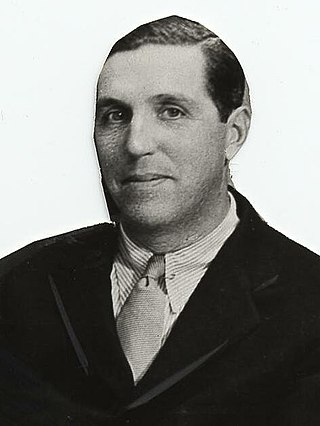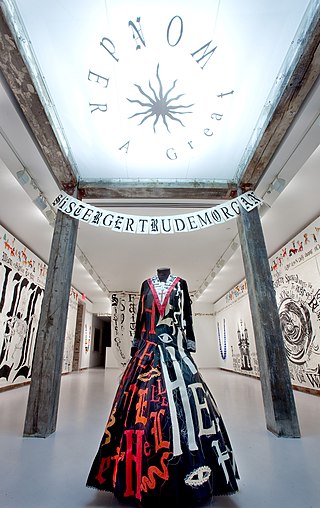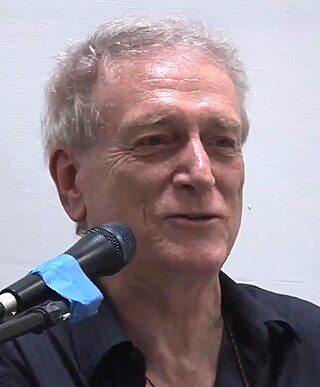
The State University of New York at New Paltz is a public university in New Paltz, New York. It traces its origins to the New Paltz Classical School, a secondary institution founded in 1828 and reorganized as an academy in 1833.

Eugene (Edward) Speicher NA was an American portrait, landscape, and figurative painter. He was one of the foremost realists of his generation who closely upheld the mantle of his mentor, Robert Henri.

Lesley Dill is an American contemporary artist. Her work, using a wide variety of media including sculpture, print, performance art, music, and others, explores the power of language and the mystical nature of the psyche. Dill currently lives and works in Brooklyn, New York.

George Quasha is an American artist and poet who works across media, exploring language, sculpture, drawing, video art, sound and music, installation, and performance. He lives and works in Barrytown, New York.
Tim Davis is an American visual artist and poet, based in New York City and Tivoli, New York. He is the author and subject of several books of photography, plus a book of poetry. He was awarded the Rome Prize in 2007.

Eva Watson-Schütze (1867–1935) was an American photographer who was one of the founding members of the Photo-Secession.
Renée C. Byer (1958) was born in Yonkers, New York.
Eugene Ludins was a leading regional American painter and academic.
Adriana Farmiga is an American visual artist, curator, and professor based in New York City. She serves as a programming advisor for the non-profit La Mama Gallery in the East Village, and is the current Associate Dean at Cooper Union School of Art.
Elisa Pritzker is an Argentine-American artist working in a variety of two- and three-dimensional art media.
Lauren Fensterstock is an American artist, writer, curator, critic, and educator living and working in Portland, Maine. Fensterstock’s work has been widely shown nationally at venues such as the John Michael Kohler Art Center (WI), the Bowdoin College Museum of Art (ME), the Portland Museum of Art (ME), and is held in public and private collections throughout the U.S, Europe, and Asia.
Lola Brooks is an educator specializing in jewelry. Brooks' works have been shown at places such as the National Ornamental Metal Museum, The Society of Arts and Crafts, Cleveland Museum of Natural History, the Museum of Craft and Folk Art, and Talente and are held in the permanent collection of The Museum of Art and Design, the Metropolitan Museum of Art.
Jamie Bennett is an American artist and educator known for his enamel jewelry. Over his forty-year career, Bennett has experimented with the centuries-old process of enameling, discovered new techniques of setting, and created new colors of enamel and a matte surfaces. This has led him to be referred to as “one of the most innovative and accomplished enamellers of our time” by Ursula Ilse-Neuman, historian and former curator at the Museum of Art and Design in New York City. Bennett is closely associated with the State University of New York at New Paltz, where he studied himself as a student, and taught in the Metal department for many years. Bennett retired from teaching in 2014, after thirty years at SUNY New Paltz.

Sara Greenberger Rafferty, is a multimedia artist working in painting, sculpture, photography, installation and performance. Her work focuses on gender and body politics in and through comedic performance. Rafferty teaches full-time at Pratt Institute and lives and works in Brooklyn, New York. Rafferty received a B.F.A. in Photography with Honors and Art History concentration from Rhode Island School of Design (RISD) and an M.F.A. in Sculpture and New Genres from Columbia University's School of the Arts. Her work was included in the 2014 Whitney Biennial and 2014 Hammer Biennial.
Myra Mimlitsch-Gray is an American metalsmith, artist, critic, and educator living and working in Stone Ridge, New York. Mimlitsch-Gray's work has been shown nationally at such venues as the John Michael Kohler Arts Center, Museum of the City of New York, Metropolitan Museum of Art, Cooper-Hewitt Smithsonian Design Museum, and Museum of Arts and Design. Her work has shown internationally at such venues as the Middlesbrough Institute of Modern Art, Stadtisches Museum Gottingen, and the Victoria and Albert Museum, and is held in public and private collections in the U.S, Europe, and Asia.

Rimer Cardillo is a Uruguayan visual artist and engraver of extensive international experience who has lived in the United States since 1979.
Marcuse "Cusie" Pfeifer was an American gallerist. Pfeifer was an important person in recognition of photography as a fine art, founding member and art exhibition director of the Hudson Valley LGBTQ Community Center in Kingston, New York, and a supporter of the Samuel Dorsky Museum of Art. She opened the Marcuse Pfeifer Gallery on Madison Avenue in 1976, and later moved to 568 Broadway. She helped people, including Sally Mann, Peter Hujar, and Timothy Greenfield-Sanders to launch their careers as contemporary photographers. In 1978, she curated a show of male nudes, with work by Robert Maplethorpe, Lynn Davis and Peter Hujar, prompting The New York Times reviewer to call for a return to "old-fashioned prudery".

George Wexler was a 20th-century American painter of realist landscapes. His work most frequently depicted scenes of mountains, woodlands, rivers and farmland in the Hudson Valley north of New York City but also included locales in the U.S. west coast and Hawaii. His earliest landscapes were influenced by the French painter Paul Cézanne, but later work became increasingly detailed and naturalistic.
Helen Johnson is an Australian artist producing large-scale paintings who also works as a lecturer, researcher and curator. Her artworks and practice reflect her views on colonialism, consumerism, the environment and personal accountability.
Barbara Seidenath is a German-born American jewelry designer, metalsmith, and educator.









